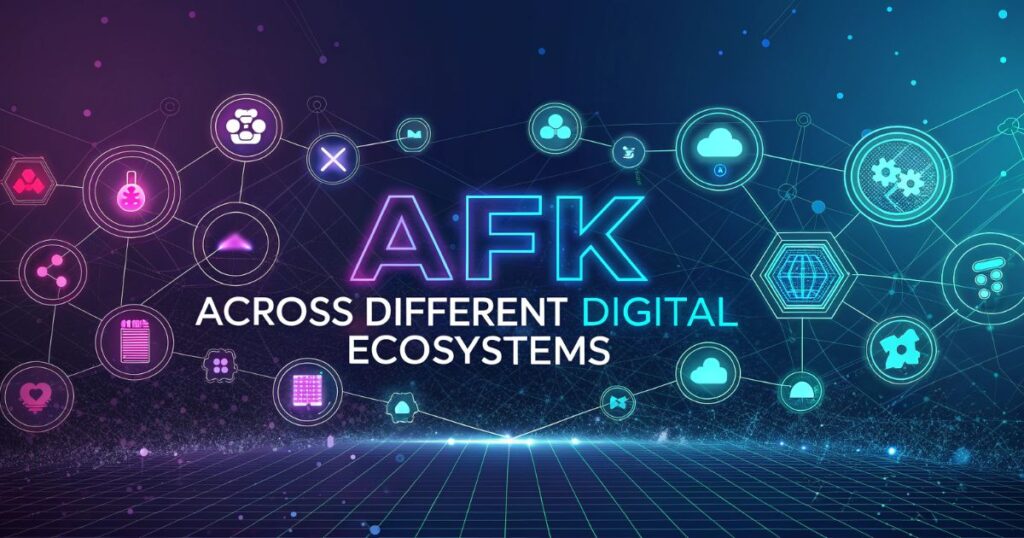You’ve encountered those three letters countless times while gaming, working, or chatting online.
AFK has become an essential piece of digital vocabulary that transcends age groups and platforms.
Understanding its proper usage can enhance your online communication and help you navigate modern digital etiquette effectively.
What Does AFK Actually Mean?
AFK stands for “Away From Keyboard” – a simple acronym that signals your temporary absence from digital activities. Originally, this meant you physically stepped away from your computer keyboard, but today’s meaning has expanded significantly.
Modern usage encompasses any situation where you’re temporarily unavailable across digital platforms. Whether you’re grabbing coffee during a gaming session or stepping into a meeting while working remotely, AFK communicates your brief departure without requiring lengthy explanations.
When Did AFK Become a Thing?
The AFK acronym emerged in the early 1990s within bulletin board systems (BBS) and Internet Relay Chat (IRC) communities. Computer enthusiasts needed efficient ways to communicate status changes during text-based conversations.
Gaming communities particularly embraced AFK during the rise of early multiplayer online games. As internet adoption soared from 16 million users in 1995 to over 361 million by 2000, AFK transitioned from programmer jargon to mainstream digital vocabulary.
AFK Across Different Digital Ecosystems

Gaming Universe Applications
MMORPGs (Massively Multiplayer Online Role-Playing Games) popularized AFK timers to prevent inactive players from occupying server slots. Games like World of Warcraft and Final Fantasy XIV automatically log out AFK players after specific timeframes.
Competitive gaming platforms implement AFK penalties to maintain fair gameplay. Battle royale games often feature AFK detection systems that remove inactive participants, while streaming platforms use AFK status to prevent stream sniping and protect content creators.
Workplace and Professional Settings
Remote work culture has transformed AFK into professional communication shorthand. Collaboration tools like Slack, Microsoft Teams, and Discord display AFK status indicators to help teammates understand availability without constant check-ins.
Professional AFK etiquette involves setting clear expectations about response times and availability windows. Teams often establish protocols for announcing extended AFK periods during crucial project phases or client meetings.
Social Media and Messaging Platforms
Discord servers feature dedicated AFK channels that automatically move inactive voice chat users. This system prevents empty voice channels while maintaining server organization and user experience.
Instant messaging applications have integrated AFK features into status systems. Users can set custom messages explaining their absence duration and expected return times, enhancing communication clarity.
What Does AFK Mean in Gen Z?
Gen Z usage extends AFK beyond literal keyboard absence to encompass general unavailability across all digital platforms. Younger users apply AFK to smartphone breaks, social media detoxes, and intentional digital disconnection periods.
Meme culture has embraced ironic AFK usage, where users announce being “AFK from life” during overwhelming periods. This evolution demonstrates how digital natives adapt traditional internet terminology to express complex emotional states and social commentary.
What Does AFK Mean in the Military?
Military communication adapts AFK for digital command centers and remote monitoring systems. Personnel use modified versions like “AFK – OPCOM” (Away From Keyboard – Operational Command) to maintain security protocols while indicating status changes.
Tactical communication systems integrate AFK concepts into battlefield management software. These applications track operator availability during critical missions while maintaining operational security through encrypted status indicators and automated personnel accountability systems.
AFK Etiquette and Best Practices
When and How to Use AFK Properly
Timing considerations vary significantly across platforms and contexts. Gaming environments typically expect immediate AFK announcements, while professional settings may require advance notice for extended absences exceeding 30 minutes.
Duration expectations depend on community norms and platform culture. Brief bathroom breaks rarely require AFK announcements, but lunch periods, meetings, or personal emergencies warrant clear communication about expected return times.
Alternative Expressions and Synonyms
BRB (Be Right Back) indicates shorter absences, typically under 10 minutes, while AFK suggests longer departures. Platform-specific alternatives include “stepping away,” “going offline,” and custom status messages with estimated return times.
International variations reflect cultural communication preferences. European gaming communities often use “Away” or “Off,” while Asian platforms may integrate native language equivalents that convey similar availability concepts.
Technical Implementation and Features
Auto-AFK systems detect user inactivity through keyboard, mouse, and application interaction monitoring. These systems typically activate after 5-15 minutes of inactivity, depending on platform settings and user preferences.
API integrations allow developers to create custom AFK functionality within applications. Privacy considerations include data collection transparency and user control over automatic status sharing across connected platforms.
Future Evolution of AFK
Emerging technologies like virtual reality and augmented reality will likely reshape AFK concepts. Metaverse platforms may introduce presence detection that considers physical movement, eye tracking, and biometric indicators beyond traditional keyboard activity.
AI-assisted status management could automatically adjust availability based on calendar events, location data, and communication patterns. These systems might predict optimal AFK timing while respecting user privacy and preference settings.
Common AFK Mistakes and Misconceptions
Overuse scenarios diminish AFK effectiveness when users constantly announce minor departures. Excessive AFK announcements can create notification fatigue and reduce the urgency perception of legitimate absence communications.
Cultural misunderstandings occur when international teams interpret AFK differently. Some cultures view frequent AFK usage as disrespectful, while others consider it essential communication courtesy for maintaining transparent availability expectations.
Conclusion
Understanding AFK meaning enhances your digital communication effectiveness across gaming, professional, and social contexts. Master these conventions to navigate online relationships while maintaining appropriate boundaries and expectations. Embrace AFK as a powerful tool for managing your digital presence in our increasingly connected world.
Frequently Asked Questions About AFK
Q: What does AFK actually mean?
AFK stands for “Away From Keyboard” and indicates temporary absence from digital activities. It originated in early internet communities but now applies to any brief departure from online platforms. Modern usage extends beyond literal keyboard absence to general digital unavailability.
Q: What does AFK mean in Gen Z?
Gen Z uses AFK more broadly to indicate breaks from all digital platforms, not just computers. They often apply it ironically in meme culture or to announce social media detoxes. Younger users treat AFK as general unavailability rather than specific keyboard absence.
Q: When did AFK become a thing?
AFK emerged in the early 1990s within bulletin board systems and IRC chat communities. It gained popularity through early multiplayer gaming and became mainstream as internet adoption grew throughout the late 1990s. The acronym transitioned from programmer slang to common digital vocabulary.
Q: What does AFK mean in the military?
Military contexts adapt AFK for digital command centers and operational communication systems. Personnel use modified versions like “AFK – OPCOM” while maintaining security protocols. Military applications focus on personnel accountability and secure status communication during tactical operations.
More Posts
Copacetic Meaning, Definition, Common Usage, and Synonyms
ETA Meaning: Exploring Its Importance in Different Contexts
Habibti Meaning: Definition, Common Usage, and Synonyms

Welcome to Brightnis! I am the admin and creator of this platform. I love questioning ideas and exploring different situations. My goal is to encourage critical thinking and help people see things from new perspectives. Join me in discussing thought-provoking topics and finding unique solutions to everyday challenges!






